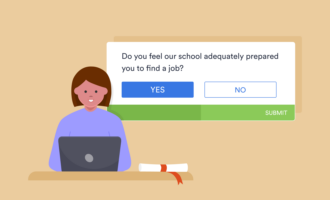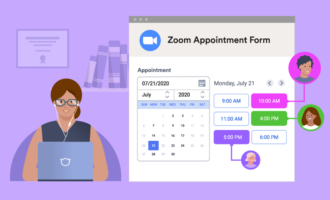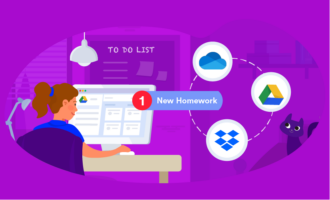Ways to update parents for teachers
- Create an interactive blog
- Use classroom messaging tools
- Post updates to social media to reach parents
- Commit to sending email newsletters
Teachers don’t just teach. They have to do an inordinate amount of administrative work every day, leaving many struggling with how to organize and prioritize their work.
One task that is especially difficult to prioritize on a busy day is sending classroom updates to parents.
Teachers understand how much parents appreciate receiving regular updates about what is happening in class and how well their children are doing. But these updates can be very time-consuming.
Parent updates don’t have to be stressful, though. A handful of familiar technologies make it easy to touch base with parents.
Pro Tip
For an insightful look into the future of higher education, explore “8 Top Trends in Higher Education to Watch in 2024” on Jotform’s blog.
1. Create an interactive blog that students help update
Classroom blogs and websites are especially useful for posting updates. What’s more, the sites’ visual nature allows teachers to easily showcase student work. These platforms are also a great way to engage parents in conversations about learning.
Linda Yollis, an elementary school teacher, advocates for using a classroom blog as a communication tool because it brings families together to discuss education. She came up with Family Blogging Month in an effort to get parents to contribute to their children’s learning by commenting on blog posts.
What can really help teachers is getting students involved with updating these sites. With some planning and creativity, write Aviva and Haskel Weiss, founders of Fun and Function, you can easily turn updating the site into a project for your students.
In doing so, you can reduce, if not eliminate, the amount of time you spend on that task. You also create an incentive for students to encourage their parents to engage with the site.
Pro Tip
Jotform offers 100+ free form integrations, letting you collect parent contact info and sync it to email apps like Mailchimp automatically. Customize a free form template to get started!
2. Use classroom messaging tools to push updates to parents
Classroom messaging tools are a great way to share updates. They allow teachers to push out updates to all parents at one time, as a group, within the messaging tool — a time-saver for teachers.
The “push” nature of these tools also helps teachers ensure that parents receive the updates. Teachers understand that not all students communicate classroom information to their parents in a timely manner. Through messaging apps, however, teachers can instantly connect to and share pertinent information with parents, explains education writer Janelle Cox. Parents, in turn, have direct access to their kids’ teachers.
Messaging tools are also extremely flexible, which helps reduce the stress of communicating with parents. Teachers can post images of flyers, pictures of student activities and work, or simply share a brief text message with parents.
There are a number of messaging apps designed specifically for teachers. Matthew Lynch, Ph.D., dean of the School of Education, Psychology, and Interdisciplinary Studies at Virginia Union University, lists some of this favorites, which include
3. Post updates to social media to reach parents where they spend time
A lot of parents already use social media, so why not reach them there?
Though somewhat controversial for education purposes (think privacy), social media can be a great tool for engaging with parents and sharing updates because there isn’t a learning curve. Parents are already comfortable with the platforms.
Facebook, Twitter, Instagram, and even Pinterest can be used to keep parents updated. The catch is that you will not likely reach all of your parents on one platform. You will probably need to update several social media accounts to reach everyone.
Knowing this, you may want to consider using social media as a secondary tool. But don’t rule it out completely if it fits your processes and helps you meet your communication obligations.
If you go this route, be mindful of school, district, and state policies about using social media to communicate with and about students, teacher Kathleen Morris warns. If you need more guidance on using social media in the classroom, Tanner Higgin at Common Sense Education has written an informative post about protecting student privacy on social media.
4. Commit to sending email newsletters on a set schedule
There are a number of programs and resources available to help teachers design newsletters — Microsoft Word, MailChimp, and Lucidpress are just a few. When using programs with templates, you can quickly create digital newsletters to update parents.
Educational consultant and former teacher Angela Watson prefers using email newsletters because it’s easy to make sure parents receive them. She believes email works well for busy parents because they can check it on their own time. And using programs with templates is a big time-saver for Watson. Once your template is created, you simply have to plug in the information and send.
The rub is that newsletters can become overwhelming if you try to create them on an ad hoc basis. The best way to get email newsletters to work for you is to set a regular schedule and commit to it. Block out the necessary time once a week, once a month, or whatever works for you, and knock it out. Then don’t work on another one until the next scheduled time.
Big picture: Set expectations with parents early
What you are trying to avoid is sending the same updates multiple times to reach all your parents, as well as constantly having to respond to their feedback. This is a drain on both your time and mental resources.
Once you have determined how you will send updates to parents, communicate that information to them at the beginning of the year, writer and mother Barbara Mariconda advises. Also, let them know what your process for responding to their replies will be. Don’t expect to be able to, and don’t try to, respond immediately to every parent. This is the quickest route to burning out.
Choose your tools, develop your processes, and then set expectations with parents early. This will help create a harmonious balance between meeting your obligations and maintaining your sanity.







































































































Send Comment:
2 Comments:
More than a year ago
Extremely interesting. Thank you for giving such an informative blog.
More than a year ago
Extremely interesting. Thank you for giving such an informative blog.